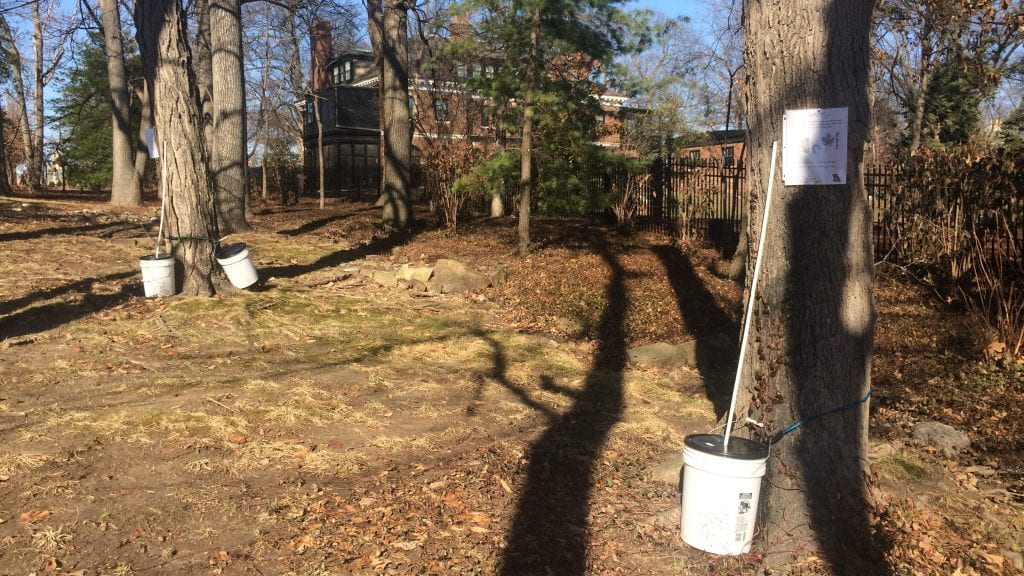As you walk up Wallace Drive from the South 40, there is a peculiar sight tucked into the landscape on your right. Tubes coming out of trees and emptying into large white buckets are almost reminiscent of an alien harvesting scene if you don’t know that they are for tapping the maple trees for sap. If you are brave enough to walk over from the sidewalk, a sign above one of the taps shares a brief note about maples and sustainable harvesting and an email to contact with more questions.
With my curiosity piqued, I went behind the scenes with Professor of biology, Stan Braude, to learn about these trees and harvesting sap from sugar maples to make maple syrup.
Five years ago, Stan began tapping the sugar maples with his Missouri’s Natural Heritage class. This course explores the diverse wildlife, plants, and habitats of Missouri and has a unit on foraging and harvesting of local resources.
Each year, a different hole is drilled into the bark of the sugar maples to make a tap. When harvesting for that season is over, the tap is removed from the tree and the tree forms a layer of woody scar tissue over the hole. The bark of tree is much like our skin in that it is our first layer of defense from harmful bacteria and is susceptible to open wounds.
Sugar maples are among the few trees that can be tapped for syrup and they are easily the most efficient due to their high sugar content. There are only three sugar maples on campus but during harvesting season these trees produce gallons of sap every few days. The buckets that collect the sap must be swapped out frequently. I was shocked to learn that the 5-gallon bucket that was about ¾ full was changed only 4 days before.
Sap is harvested from the xylem of the tree, which is rich in sugar during the winter, acting as a kind of anti-freeze for the tree. The best time to harvest sap in Missouri is around the months of January and February as this time has slightly warmer days and freezing nights. Sap flow is caused by pressure changes in the stem due to alternating 24-hour cycles of warm days and night freezes. Cool evening temperature generates negative pressure as gasses are compressed in the freezing water of the xylem and drawn into the roots. In the heat of the day, ice melts and causes the trapped gasses to expand in the stem which generates positive pressure. This pushes the sap up from the roots and the stem and out of the tap. Stan compared this process using an analogy of a can of soda. When the soda is cold, and the can is opened in warm air it releases more gasses more rapidly.
An experimental ecology class at WashU taps 14 sugar maple trees at Tyson research center. The class looks at other factors that may impact sap productivity like what slope (north or south) the trees are growing on and the proximity to neighboring trees of the same species.
Sugar maples grow best and most frequently ranging from Wisconsin, to New York and into Canada. The easiest time to identify sugar maples is in the fall due to their brilliant orange and gold leaves. In the winter, look for big stretches of bark that curve away from the tree.
“When hiking in Missouri you are primarily going through native oak-hickory forest but when you come across a cluster of maple trees you should look for an old foundation. The reason for this is because settlers in the area were accustomed to maple trees and wanted to harvest sap for maple syrup and also appreciated their fast growth for shade around their homes”, explains Stan.
As for the process of making maple syrup, it takes about 40 liters of sap to produce 1 liter of maple syrup. Stan and the Missouri’s Natural Heritage class undertake the all-day process of boiling down maple sap into syrup at the Dauten firepits. All the while, the class flips heaps of pancakes to eat their hard-earned syrup with. This year’s syrup-making event will take place on the first Friday of March and anyone is more than welcome to come learn more about sugar maples and taste the delicious campus-grown maple syrup.
If you have additional questions about tapping for maple sap, foraging for local food, or the maple syrup making event contact: braude@wustl.edu
Visit https://pages.wustl.edu/mnh to learn more about Missouri’s Natural Heritage.
This article was written by communication intern, Kristen Patino.
